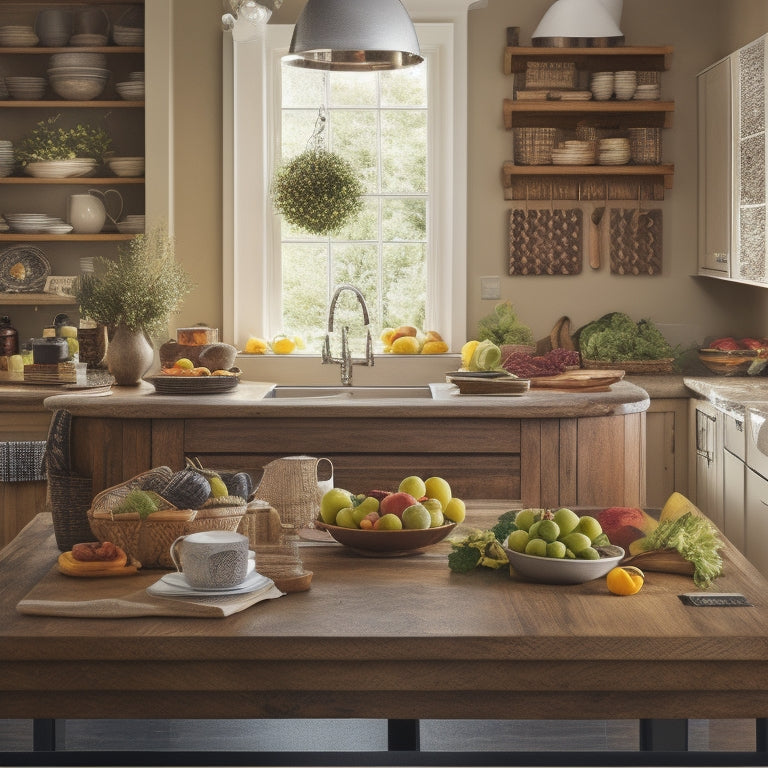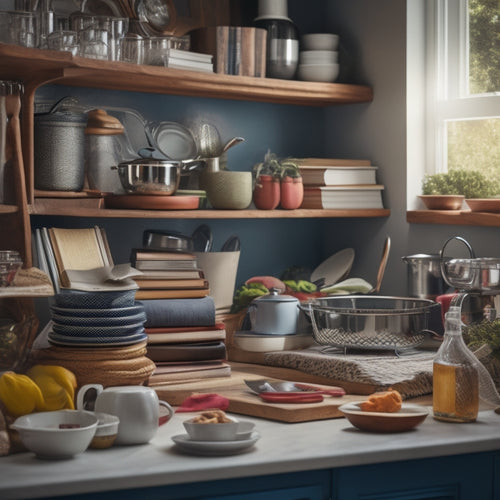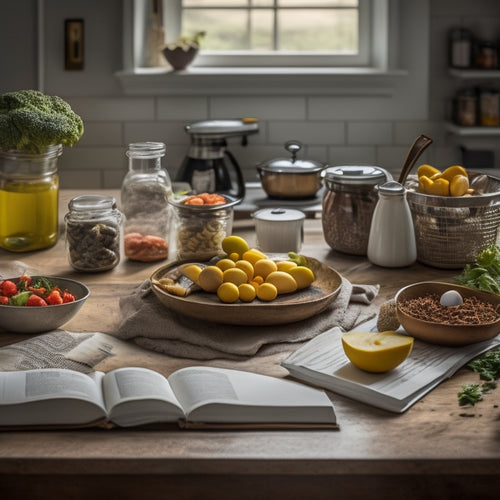
Mastering Meal Planning for a Clutter-Free Kitchen
Share
You're tired of the kitchen chaos and meal planning overwhelm. It's time to transform your space into a calm, controlled oasis. Start by identifying clutter sources, tackling pantry inventory, and utilizing baskets and labels for organization. Next, prioritize quick recipes, adopt time-saving tips, and keep meals simple. Create a customized meal plan that fits your preferences and dietary needs. With the right tools and strategies, you'll be on your way to a clutter-free kitchen and a more efficient you. Now, take the first step towards a more organized, stress-free cooking experience – and discover how to make meal planning a breeze.
Key Takeaways
• Identify clutter sources in the kitchen and organize pantry inventory for accessibility and calm control.
• Adopt meal planning strategies like prioritizing quick recipes, prepping in advance, and keeping meals simple for efficiency.
• Manage grocery lists by categorizing items, avoiding duplicates, and reducing food waste to save time and money.
• Utilize template tools like meal planning, grocery list, and recipe organizers to achieve digital organization and master meal prep hacks.
• Simplify meal planning by tailoring meals to preferences, dietary needs, and busy schedules, and start small to gain confidence.
Kitchen Chaos to Calm Control
Take control of your kitchen by identifying the sources of clutter and chaos that have been driving you crazy, from countertops cluttered with appliances to overflowing cupboards and drawers. It's time to transform your kitchen from a stress-inducing space to a haven of calm control.
Start by tackling your pantry inventory. Take everything out and sort items into categories: staples, snacks, and ingredients. Discard expired or unnecessary items, and group similar items together. Assign a home for each category, making sure it's easily accessible. Use baskets, bins, and labels to keep items organized and visible.
Implementing organization hacks will help maintain your newly organized pantry. Designate a specific spot for frequently used items, like a 'launching pad' for your morning coffee or a 'landing strip' for your keys. Utilize vertical space by installing shelves or hooks for infrequently used items.
Meal Planning for Busy Lives
With your newly organized pantry in place, you're ready to tackle the next challenge: meal planning that fits your fast-paced lifestyle, where every minute counts and flexibility is key. You need a plan that's adaptable, efficient, and delicious. Here are some strategies to get you started:
| Time-Saving Tip | Quick Recipe |
|---|---|
| Prep in advance | One-Pot Pasta with Tomatoes and Basil |
| Keep it simple | 15-Minute Chicken Fajitas |
| Shop smart | Overnight Oats with Fresh Berries |
When meal planning for your busy life, prioritize quick recipes that can be prepared in no time. Look for dishes that use common ingredients, can be cooked in one pot, or require minimal prep time. Additionally, adopt time-saving tips like prepping in advance, keeping meals simple, and shopping smart. By incorporating these strategies into your meal planning routine, you'll save time, reduce stress, and enjoy healthy, satisfying meals even on the most chaotic days.
Grocery Lists Made Easy
You can simplify your meal planning process further by creating a grocery list that's just as efficient, ensuring you have all the necessary ingredients on hand when you need them. A well-organized grocery list helps you avoid last-minute takeout or wasted ingredients, saving you time and money.
To create a seamless grocery list, consider the following strategies:
-
Pantry organization: Take stock of your pantry staples and note what you need to restock. This helps you avoid duplicate purchases and reduces food waste.
-
Meal prep strategies: Plan your meals for the week, and make a list of the ingredients you need for each recipe.
-
Group similar items together: Organize your list by category (e.g., produce, dairy, meats) to make shopping more efficient.
- Check what you already have: Before you head to the store, take a quick glance at what you already have in your pantry, fridge, and freezer to avoid buying unnecessary items.
Template Tools for Success
Four essential template tools can streamline your meal planning process and help you stay organized. You'll be amazed at how these tools can transform your kitchen into a clutter-free zone.
First, a meal planning calendar template helps you visualize your weekly menu, making it easy to plan and prep meals.
Next, a grocery list template guarantees you don't forget essential ingredients, reducing food waste and saving you time.
A recipe organizer template is also a game-changer, allowing you to store and categorize your favorite recipes digitally.
Finally, a meal prep planning template helps you prep ingredients and meals in advance, making meal prep a breeze.
By leveraging these template tools, you'll achieve digital organization and master meal prep hacks. You'll be able to plan, shop, and cook with confidence, freeing up time and energy for more important things.
With these tools, you'll be well on your way to a clutter-free kitchen and a more organized you!
Customizing Your Meal Plan
To accommodate your dietary needs and preferences, start by identifying the types of meals you enjoy cooking and eating, and then tailor your meal plan accordingly. This means considering your dietary restrictions and making recipe modifications to suit your needs. For instance, if you're gluten-free, swap out traditional pasta for gluten-free alternatives.
To make sure your meal plan remains flexible, consider the following:
-
Be open to meal swaps: if you're not in the mood for a particular dish, swap it out for something else that still meets your dietary needs.
-
Schedule meals around your busy days: if you know you have a packed schedule on Wednesday, plan for a quick and easy meal that can be prepared in no time.
-
Keep a list of pantry staples: this will help you whip up a meal quickly if you need to make a last-minute change.
- Leave room for spontaneity: life can be unpredictable, so don't be too hard on yourself if you need to make changes to your meal plan on the fly.
Overcoming Meal Planning Fears
Meal planning fears often stem from feeling overwhelmed by the perceived complexity of the process or anxiety about making mistakes, but recognizing these fears is the first step towards overcoming them. You're not alone in feeling this way, and it's crucial to acknowledge that meal planning is a skill that can be developed over time.
To begin, focus on simplifying your approach. Start by planning meals that you know your family will enjoy, and consider budget-friendly meals that won't break the bank. You can also find inspiration online or through meal prep tips from experienced home cooks. Remember, the key is to start small and be flexible – don't be too hard on yourself if things don't go as planned.
As you gain confidence, you can experiment with new recipes and ingredients. You'll soon find that meal planning becomes second nature, and you'll be able to whip up a healthy, delicious meal with ease.
Streamlining Meal Prep Time
Your kitchen timer becomes your best friend when you're able to prep ingredients in advance, shaving precious minutes off your cooking time. This is where streamlining meal prep time comes in – a pivotal step in mastering meal planning for a clutter-free kitchen.
By implementing efficient cooking strategies, you'll be able to cook more in less time, freeing up space in your schedule for more important things.
Here are some time-saving tips to get you started:
-
Chop in bulk: Chop all your veggies for the week in one go, and store them in airtight containers for easy access.
-
Prep proteins in advance: Marinate, season, or cook proteins like chicken, beans, or tofu ahead of time to use in future meals.
-
Make a 'mise en place': Prepare all the ingredients needed for a recipe before starting to cook, ensuring a smooth and efficient cooking process.
- Designate a 'landing strip': Assign a specific area in your kitchen as a 'landing strip' for ingredients and cooking tools, keeping them organized and within reach.
Maintaining a Clutter-Free Space
You've optimized your meal prep time, now it's time to turn your attention to maintaining a clutter-free space that makes cooking and cleaning a breeze.
To achieve this, focus on implementing effective storage solutions and organization tips that work for you. Start by decluttering your kitchen, getting rid of any unnecessary items that are taking up valuable space.
Once you've purged your kitchen, it's time to optimize your space. Assign a home for each item, making sure everything has a designated spot. This will help maintain a sense of order and make cleaning a breeze.
Utilize vertical space by installing shelves or hooks to maximize storage. Implement a 'one in, one out' policy to prevent clutter from building up again.
Frequently Asked Questions
How Do I Account for Food Allergies and Intolerances in My Meal Plan?
'As you navigate meal planning, you're suddenly faced with a challenging challenge: accommodating food allergies and intolerances. But fear not! By substituting ingredients and creating allergen-free recipes, you'll masterfully craft meals that are safe and delicious for all.'
Can I Use Meal Planning for a Family With Very Different Tastes?
You can definitely meal plan for a family with diverse tastes! Make dietary compromises by incorporating family favorites and customized meals that cater to each person's unique palate, ensuring everyone gets what they love.
What if I Don't Have Time to Cook Every Day?
If you're short on time, you can't cook daily; try batch cooking and meal prep on weekends, then freeze meals for later, using leftovers to whip up quick dinners that save you time and energy.
How Do I Handle Last-Minute Changes to My Meal Plan?
When last-minute changes hit, you adapt by making emergency substitutions and quick recipe adjustments. Swap out ingredients, adjust cooking times, and repurpose leftovers to salvage your meal plan and stay on track.
Is It Possible to Meal Plan on a Very Tight Food Budget?
You're balancing a tightrope of flavors on a shoestring budget. You can still savor delicious meals by making creative substitutions, buying in bulk, and planning around affordable protein sources, ensuring every bite is a culinary masterpiece.
Related Posts
-

7 Best Kitchen Shelf Organizers for Heavy Cookbooks
You're looking for a kitchen shelf organizer that can handle your extensive collection of heavy cookbooks. You'll fin...
-

Why Keto Dieters Need a Meal Planning System
You need a meal planning system to supercharge your keto diet because without one, you'll be stuck in a vicious cycle...

